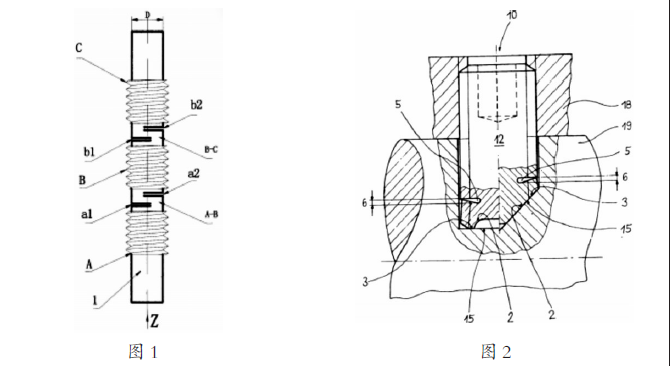
Keyword selection significantly impacts the efficiency and accuracy of searches. When analyzing the characteristics of a case during a search, one can start from the invention concept and details, selecting keywords that are easier to express. When it is difficult to express the invention’s technical solution with keyword combinations, one can delve into the concept or details, choosing keywords that express a single idea and yield a moderate amount of literature, thus effectively improving search efficiency by avoiding keywords that would generate excessive literature.
Keywords that can describe the invention concept
First and foremost, accurate expression of keywords is crucial and key to enhancing efficiency. In recent years, a recommended practice is to utilize the invention concept for searches, meaning that keywords that can describe the invention concept should be selected during the search. This requires technical personnel in the field to understand the substantive connotation of technical features when constructing search queries, rather than being limited to the textual expressions in the claims or descriptions.
Case 1:
Claim 1: An energy-saving LCD control system based on a flow measurement device, including an LCD power control module, an LCD interface module, and an LCD display module, where the LCD power control module is connected to the LCD interface module, and the LCD interface module is connected to the LCD display module; characterized in that the LCD power control module includes a P-channel MOSFET, a power supply port for powering the LCD display module, a first signal control port for controlling the on/off of the LCD power control module, a first resistor, and a first capacitor. The power supply port is connected to the ground and the gate of the P-channel MOSFET through the first capacitor and the first resistor, and the power supply port is also connected to the source of the P-channel MOSFET, with the gate of the P-channel MOSFET connected to the first signal control port, and the drain of the P-channel MOSFET being the output of the LCD power control module.
For the above solution, if one is constrained by the technical features in the claims and expands and searches using aspects like LCD, power control, interface, switch, etc., it would lead to a very large amount of literature to browse. However, through analysis of the solution, it can be seen that this case adds a control circuit to the traditional LCD circuit of a water meter, achieving on/off control of the LCD power, saving energy consumption, and combining common knowledge that turning off the LCD in instruments saves battery power is actually done by turning off the LCD backlight. Thus, the keywords “backlight” and “control” can be determined, combined with the classification number for water meters and gas meters, to quickly obtain comparative documents of Class X: CN 201440078U.
Search query: CNTXT g01f15/ic and backlight and control. It can be seen that in the above search, closely adhering to the core of the invention, combined with technical common knowledge in the field, considering the overall technical solution to be protected, using accurate and reasonable expressions to describe the overall solution of the case can efficiently retrieve comparative documents, representing a rapid search strategy. During the examination process, there are many times when keywords describing technical effects are also chosen for searches. In fact, since effects are also an overall embodiment of the invention concept, searching for effects is actually a form of searching for the invention concept.
Keywords that can describe the invention details
When searching, if it is difficult to accurately express the invention concept or if the keywords expressing the concept are conventional and lack distinction, one can also start from the invention details. Utilizing the details of the invention, especially those recorded in the embodiments, can more specifically and accurately describe the key means of the case, thus quickly obtaining comparative documents that are more relevant and easier for creative evaluation.
Case 2:
Claim 1: An acoustic and optical alarm circuit, characterized in that it includes a first resistor, a second resistor, a third resistor, a fourth resistor, a first transistor, a second transistor, a diode, and a relay, as well as an alarm bell or alarm light; one end of the first resistor is connected to the control signal terminal, and the other end is connected to the B terminal of the first transistor, the E terminal of the first transistor is grounded and connected to the positive terminal of the diode and one end of the relay, the C terminal of the first transistor is connected to one end of the second resistor, the other end of the second resistor is connected to the B terminal of the second transistor and one end of the third resistor, the other end of the third resistor is connected to the power supply and the E terminal of the second transistor, and the C terminal of the second transistor is connected to the other end of the diode and the other end of the relay; the diode and relay are connected to the second transistor, with one end grounded for the alarm bell or connected to the negative terminal through the fourth resistor for the alarm light.
The claims of this case limit only the connection method of circuit components. In fact, when searching, one can also start from the invention concept, that is, the control circuit controls the alarm device to emit acoustic and optical alarms. However, there are no effective keywords that can limit the literature volume, and since Claim 1 is entirely about circuit connections, if only comparative documents of the disclosed concept are available, it is also difficult to conduct feature comparisons when evaluating creativity. From the perspective of facilitating creative evaluation, it is still hoped to have a relatively similar circuit structure. Therefore, analyzing the circuit connection method in the description’s figures, the control circuit is actually a cascade of NPN and PNP transistors to control the relay and trigger the alarm. This means that if one can find alarm control circuits with cascaded NPN and PNP transistors, it would be a relatively effective comparative document. Thus, using NPN and PNP, resistors, and relays as keywords for searching can quickly yield many effective comparative documents.
Search query: CNTXT g08b/ic and (NPN p PNP p resistor) and relay. It can be seen that directly starting from the details of the solution in the description and selecting vocabulary that can better express specific technical content can sometimes quickly obtain highly relevant comparative documents.
Keywords that do not require extensive expansion
Both of the above search cases primarily rely on keywords to describe the invention. By using combinations of multiple keywords and conjunctions, they can effectively express the solution and quickly obtain comparative documents, which is suitable for those familiar with the field or for searches in Chinese databases. However, for some mechanical structure cases, especially when searching in foreign databases, it is often difficult to express using combinations of keywords, necessitating the use of appropriate sub-classification numbers. In searching such cases, most people generally adopt a strategy of conducting a preliminary search, using higher-level classification numbers with a few keywords to attempt to adjust the search strategy further.
Although it is a preliminary search, it is also necessary to control the literature volume to a certain extent to quickly find relevant literature. Therefore, the selection of keywords during preliminary searches is also very important. If the selected keywords are relatively conventional and have multiple expressions, the search efficiency is not high. Firstly, such words, even with simple expansions, will lead to a large volume of literature. Secondly, during subsequent expansions, it will also cause repeated browsing of literature, especially since many documents may not even mention a certain feature in their abstracts, which is particularly evident in foreign databases. Therefore, starting a search with keywords that will lead to a large volume of literature or their expansions is actually a low-cost approach. Thus, during searches, especially in foreign databases, one should start from the concept (e.g., technical problems or technical effects) and details, trying to select expressions that are relatively singular and can express part of the features of the search elements while ensuring that the search results are suitable for browsing. In the initial stages of searching, one can abandon keywords that require extensive expansion. The author uses the 2019 National Intellectual Property Administration’s patent search competition mechanical questions as an example for illustration:
Case 3:
Claim 1: An anti-seismic self-locking threaded fastener, including a threaded pair composed of an external thread on a screw and an internal thread on a nut, characterized in that the same screw has at least two independent and mutually offset threaded sections, with at least two or more radial grooves symmetrically distributed about the axis and mutually offset on the smooth cylindrical surface between the screw’s threaded sections (see Figure 1).

Step 1: Preliminary analysis of the solution
Analyzing the claims of the solution, the main feature is the presence of grooves on the screw. A conventional and relatively easy search approach would be to use the classification number related to screws along with keywords about grooves. However, the expression for “groove” in English is diverse, and if one were to expand keywords for this structure, it would not necessarily be comprehensive, and the use of this term would lead to a very large volume of literature, requiring further combination with other keywords to narrow it down, which would actually weaken the previous comprehensive expansion effect of “groove,” resulting in unsatisfactory search results. Further analysis of structural characteristics is needed to attempt to bypass keywords that could lead to a large volume of literature and those that require extensive expansion.
Step 2: Selecting Chinese and English keywords
Further analyzing the structural characteristics, the “groove” in the above solution has a detail characteristic: it is a groove set on the “smooth rod” of the screw. First, the term “smooth rod” is selected, and its English expression is also singular. Introducing the term “smooth rod” in the Chinese database can quickly yield relevant documents, and the relevant literature obtained from the Chinese database can provide a relatively relevant classification number F16B39/28.
Subsequently, the same approach is used to search in the VEN database with this term, but the literature retrieved is mostly in Chinese, indicating that this expression is not commonly used in English. In the English database, further suitable keywords need to be found. Analyzing the characteristics of the “groove,” it is found that this groove has a detail characteristic: it is a “radial” groove. Combined with the meaning of classification number F16B39/28 (which indicates locking during tightening through special elements or shapes on the screw), adding the term “radial” attempts to express locking achieved through radially arranged elements or shapes, which encompasses the form of radial grooves. If the literature is browsable, the expression of grooves can be omitted for limitation. The search query is as follows:
Search query: VEN f16b39/28/low/ic and radial and pd<2005. This yields relatively close comparative documents DE3319244 A1, as shown in Figure 2. This comparative document can serve as Class X literature for evaluating creativity.
Step 3: Tracking the obtained relevant literature to avoid using keywords. After retrieving a comparative document that can evaluate creativity from the above literature, tracking it (citing and being cited) can yield Class X literature US2576438 A (published in 1951, evaluable for creativity). Using the newly obtained literature for further tracking can yield another Class X literature US2224659 A (published in 1940, evaluable for novelty). Both documents from 1951 and 1940 do not have abstracts, and if searched using keywords, there is a high probability of missing them.
Observing the retrieved literature, it is found that they commonly use the classification number F16B39/286 (caused by saw marks), which indicates locking during tightening using “saw marks.” It can be seen that there is no need to use expressions related to “grooves” for limitation. Therefore, finding a precise sub-classification that can express the technical solution of the invention is essential. To ensure thoroughness, if the literature is browsable, only using this classification number is sufficient:
Search query: VEN F16B39/286/ic and pd<2005.
This retrieves two Class X documents FR2621363 A and WO0055512A, which can evaluate novelty.
Step 4: Filling in gaps
At this point, one can further mine from the relevant literature obtained to check for any missing classification numbers or other effective expressions to fill in the gaps. From FR2621363A, it is found that the structural screw can be used in vibrators, providing a classification number of h03b1/00. Searching screws under this classification number reveals that in Section H, this type of elastic anti-loosening screw is often referred to as a tuning screw. Further searching with this keyword yields Class X literature US4598334 A (evaluable for novelty).
From the above search process, it can be seen that for the main feature of the solution, “groove,” the search process did not expand on this expression, and did not even use the keyword “groove,” yet multiple effective documents that can evaluate novelty or creativity were quickly retrieved. Regarding the Class X literature retrieved, only a few documents mentioned the feature of grooves in their abstracts, indicating that even if the term “groove” were to be expanded comprehensively, searching with the keyword “groove” would lead to browsing a large volume of literature while only obtaining a few effective comparative documents, resulting in unsatisfactory search quality and efficiency.
For searches in foreign databases, especially for structural technical features, it is advisable to avoid using keywords for expression. However, since many times one may not know the sub-classification numbers or do not have suitable sub-classification numbers, it is necessary to choose keywords for limitation. In such cases, when selecting keywords, one can choose features that are relatively clear, singular, and easy to express, which will not lead to a large volume of literature that cannot be browsed. Through preliminary searches, one can further obtain sub-classification numbers or other relevant keyword expressions, and even obtain relatively relevant comparative documents, allowing for rapid retrieval through tracking.
In searching in Chinese databases, one can start from the invention concept or details, utilizing combinations of keywords to accurately express the technical solution or key means of the solution. In searching in foreign databases, one should be cautious not to use keywords to express multiple basic search elements; ideally, only one or two basic search elements should be expressed with keywords. When selecting keywords, one can start from the concept (e.g., technical problems or technical effects) and details, striving to choose relatively singular expressions that can express part of the features of the basic search elements while ensuring that the search results are suitable for browsing. (National Intellectual Property Administration Patent Examination Department of Optoelectronic Technology Li Han)
(This article represents the author’s personal views)
(Source: China Intellectual Property Report Original Title: How to Select Keywords for Patent Searches)
(Editor: Lü Ke Ke Editor: Gao Yun Xiang Reviewed by: Cui Jing Si Cai Ying)
(Exclusive article from China Intellectual Property Report, unauthorized reproduction is prohibited)
